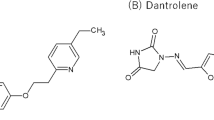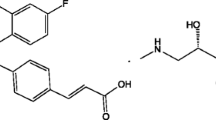No Heading
Purpose.
To evaluate the effect of pH on solubility and dissolution rates of a model weak base, haloperidol, and two different salt forms, hydrochloride and mesylate.
Methods.
pH-solubility profiles were determined by using haloperidol base, haloperidol hydrochloride, and haloperidol mesylate as starting materials; concentrated or diluted HCl or NaOH solutions were added to aqueous suspensions of solids to adjust pH to desired values. Intrinsic dissolution rates were determined using intrinsic dissolution apparatus under various pH-stat conditions. Further, approximation of diffusion layer pH was estimated from that of 10% w/w slurries of drug substances in dissolution media, which were used to correlate with intrinsic dissolution rates of haloperidol and its salt forms under different pHs.
Results.
pH-solubility profiles of haloperidol base and its HCl salt were similar, while when the mesylate salt was used as starting material, it exhibited a higher solubility between pH 2 and 5. The higher solubility of the mesylate salt at pH 2–5 is attributed to its higher solubility product (Ksp) than that of the hydrochloride salt. The pH-solubility profiles indicated a pHmax (pH of maximum solubility) of ∼5, indicating that the free base would exist as the solid phase above this pH and a salt would be formed below this pH. Below pH 1.5, all solubilities were comparable due to a conversion of haloperidol base or the mesylate salt to the HCl salt form when HCl was used as the acidifying agent. These were confirmed by monitoring the solid phase by differential scanning calorimeter. When their dissolution rates are tested, dissolution rates of the mesylate salt were much higher than those of the free base or the HCl salt, except at very low pH (<2). Dissolution rates of free base and HCl salt also differed from each other, where that of HCl salt exhibits higher dissolution rates at higher pHs. A direct correlation of dissolution rate with solubility at diffusion layer pH at the surface of dissolving solid was established for haloperidol, its hydrochloride, and mesylate salts.
Conclusions.
Using pH-solubility and pH-dissolution rate interrelationships, it has been established that diffusion layer pH could be used to explain the observed rank order in dissolution rates for different salt forms. A non-hydrochloride salt, such as a mesylate salt, may provide advantages over a hydrochloride salt due to its high solubility and lack of common ion effect unless at very low pH.
Similar content being viewed by others
References
1. S. M. Berge, L. D. Bighley, and D. C. Monkhouse. Pharmaceutical salts. J. Pharm. Sci. 74:815–820 (1977).
2. K. R. Morris, M. G. Fakes, A. B. Thakur, A. W. Newman, and A. T. M. Serajuddin. Integrated approach to the selection of optimal salt form for a new drug candidate. Int. J. Pharm. 105:209–217 (1994).
3. P. L. Gould. Salt selection for basic drugs. Int. J. Pharm. 33:201–217 (1986).
4. A. T. M. Serajuddin and C. I. Jarowski. Effect of diffusion layer pH and solubility on the dissolution rate of pharmaceutical bases and their hydrochloride salts. Part 1. Phenazopyridine. J. Pharm. Sci. 74:142–147 (1985).
5. W. Q. Tong and G. Whitesell. In situ screening – a useful technique for discovery support and preformulation studies. Pharm. Dev. Tech. 3:215–223 (1998).
6. M. T. Ledwidge and O. I. Corrigan. Effects of surface active characteristics and solid state forms on the pH solubility profiles of drug-salt systems. Int. J. Pharm. 174:187–200 (1998).
7. B. D. Anderson and K. P. Flora. Preparation of water-soluble compounds through salt formation. In Wermuth CG (ed.), The Practice of Medicinal Chemistry, Academic Press, London, 1996, pp. 739–754.
8. A. T. M. Serajuddin and C. Jarowski. Effect of diffusion layer pH and solubility on the dissolution rate of pharmaceutical acids and sodium salts II: salicylic acid, theophylline, and benzoic acid. J. Pharm. Sci. 74:148–154 (1985).
9. S. F. Kramer and G. L. Flynn. Solubility of organic hydrochlorides. J. Pharm. Sci. 61:1896–1904 (1972).
10. J. B. Bogardus and R. K. Blackwood. Dissolution rates of doxycycline free base and hydrochloride salts. J. Pharm. Sci. 68:1183–1184 (1979).
11. M. Pudipeddi, A. T. M. Serajuddin, D. J. W. Grant, and P. H. Stahl. Solubility and dissolution of weak acids, bases, and salts. In Stahl PH and Wermuth CG (eds.), Handbook of Pharmaceutical Salts – Properties, Selection, and Use, Verlag Helvetica Chimica Acta, Zurich, 2001, pp. 19–39.
12. K. G. Mooney, M. A. Mintun, K. J. Himmelstein, and V. J. Stella. Dissolution kinetics of carboxylic acids. Part 1. Effect of pH under unbuffered conditions. Part 2. Effect of buffers. J. Pharm. Sci. 70:13–22 (1981).
Author information
Authors and Affiliations
Corresponding author
Rights and permissions
About this article
Cite this article
Li, S., Wong, S., Sethia, S. et al. Investigation of Solubility and Dissolution of a Free Base and Two Different Salt Forms as a Function of pH. Pharm Res 22, 628–635 (2005). https://doi.org/10.1007/s11095-005-2504-z
Received:
Accepted:
Published:
Issue Date:
DOI: https://doi.org/10.1007/s11095-005-2504-z




